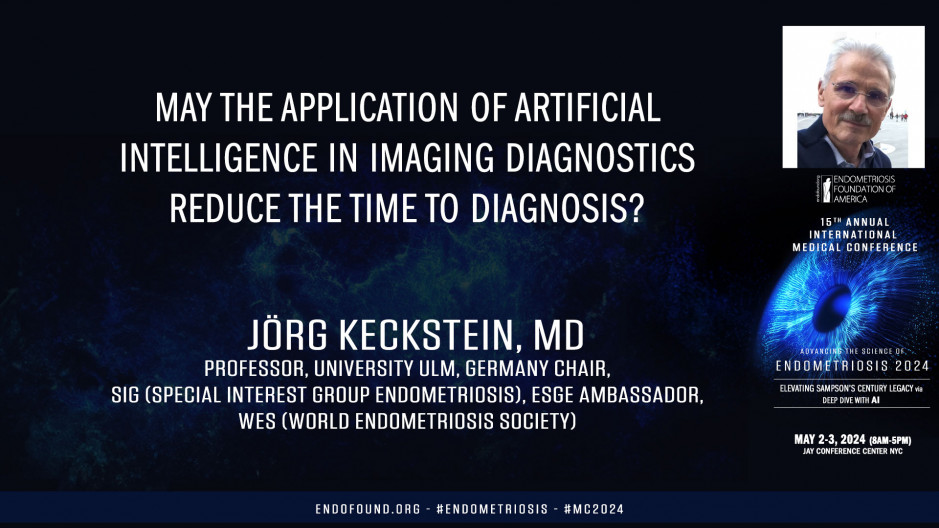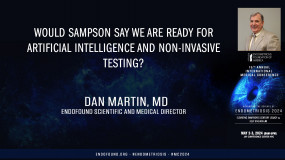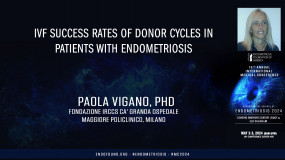International Medical Conference
Endometriosis 2024:
Elevating Sampson’s Century Legacy via
Deep Dive with AI
For the benefit of Endometriosis Foundation of America (EndoFound)
May 2-3, 2024 - JAY CENTER (Paris Room) - NYC
So that's fine, that's fine. So let's start Now this is a task which is not so easy, but maybe when we listen, we have been listen all to the presentation. We are still thinking we are missing data. We need more data. Always we say we need further studies. And this is a big problem. I hear myself. So
We have still a delay of the diagnosis which is obvious and this has a very dimensional effect for the patient and the disease progression. The diagnostic is made. All of you know how we first do an ssis, we take the history and so on and we do the imaging. When we talk with a patient we get so much information. But most of this information get lost. And when you see here, this is a study which used all this information of the Anis and they trained the artificial intelligence by just analyzing the history just by this. And they trained it and then they used it in normal narrative and structured reports. And you can see this is the training set. First you use it for training and then you used it in a patient group. And it's a very similar result, just taking the history of the patient to get the right diagnosis and it was proved by the laparoscopic diagnosis. That means that maybe with just taking the good anamnesis we can make the diagnosis without surgery.
We know in the meantime that imaging is mandatory and we have a very high sensibility and specificity in rectal endometriosis called literation vaginal wall involvement and the septum rectal vaal. And there is a comparison between diagnostic laparoscopy and transvaginal ultrasound. And it is clear that with this new technique you're able to identify this in more than 95%. So using now the physical examination, the transvaginal ultrasound and the MRI, we have very high accuracy and taking together we can improve that. That means the more we know, the more we get from the patient, the probabilities to make the right diagnosis. So this is a paper which will be published in the next month in four different journals, human reproduction, jmic and in ultrasound, obstetrics and gynecology and in fact fusion and vision. And this is a very interesting statement, consensus statement which with 51 experts and the result is vaginal ultrasound is the first line of imaging. But the next is we need training skill, experience. And what does mean? Experience? Experience is just another word for my mistakes.
So that's our problem in the hands of experts, we can calculate it perfectly and we have very high information. This is our problem. It's clear, it's established, but the biggest limitation is the lack of the trained people. And this restricts the access and diagnosis for many people to have the right diagnosis. This is our problem. How is it in North America for example? It's managed by radiologists, but the radiologists are not specialists on endometriosis. They're doing such different things and they do also a little bit endometriosis. How can you get the expertise in this group?
There are no guidelines. We can talk about guidelines. And another thing is many clinicians, they don't believe in imaging. So this is a problem. Is there a place? So look here, this is a very interesting, the percentage of experts, they believe that this they expect is different in each country. Australia, New Zealand is much better than UK or Canada. That means we have different experts and we Bruno said yesterday how different worldwide we have the expertise on imaging. But when you look what they believe, these same expert believe that it's possible but they don't expect it from their own patients. So there is a gap between the expectation and the reality. So why we have this lack, it's because we don't have the skill. And why don't we have the skill? Because lack of time, you see for the transvaginal ultrasound, normal ultrasound and expert ultrasound for endometriosis.
And you can see this is the different of time and exactly this time problem we have in daily work. People do not investigate patient correctly. If you send all these to the experts, it's impossible. And that's we have the gap and the lack of information for most of the patient preoperatively. So when we use now the artificial intelligence, how can we do it so we can facilitate the analysis? We might and we can provide valuable insight in the disease which we cannot do on normal way and we can classify and we can better plan it. So this was the first study we used in 2017. We wanted to analyze our pictures in more than 15,000 pictures to analyze the laparoscopic finding with artificial intelligence. So we tried to augment to make augmentation of these pictures with rotating the pictures by blurring cropping and transform. And we analyzed it and it was we can augment the main problems.
We do not have enough data at the moment that we have to use data sets. And this is a dataset which is called blender. And it can be used by every one of you. You can download it and you can work with this blender by own. And that's what we are missing. We do not have open data sets and that's what we need for the future, not in each little institute. We need global data sets and everybody can work on it with thousands of people. This is the future. Now the ultrasound in ovarian endometriosis sometimes very difficult. You see adhesions, complex ovarian disease here with kissing ovaries. So this is very difficult that we have the yotta criteria and they are very simple. And now this criteria were used by a group they used to distinguish between the OIDs and ovarian cyst. And with this artificial int intelligence, it was useful to train the residents to improve the quality of the patient and they received the same quality in comparison to the experts.
And that's what we want the expert. The artificial intelligence must not be better but at least the same level the expert is because most of the people are not experts. And this is our main problem for our patient daily work. So how about adenomyosis in MRI, ultrasound and surgery, this is a big miotic tissue. We did a ute sparing surgery. There's a very interesting paper to analyze the volume of the uterus and this is important. And if we have for example this data for the IVF centers, Paola showed it, if we have only the volume of the uterus would be very helpful just by artificial intelligence and they could demonstrate that you can really accurate judge the volume of the uterus. Very simple. So see this is a very interesting approach. How about deep endometriosis? You see here the depletion on the rectum and on the vagina and the first study was done by Guerrero.
Here is an son of, and he showed with the different artificial systems that but it were only 333 patients, not many. So he showed that very high accuracy with the different models and it was very similar to the logistic model. Another paper showed that the sliding sign, the sliding sign is to diagnose the culdesac obliteration. And with this technique Michael could demonstrate that this augmented reality showed that you can identify very with a high accuracy and with a very high positive predictive value. And the same was here. And this is an interesting paper which shows this is the ultrasound picture and this is the MRI. And we know that the MRI is not very good to diagnose cul-de-sac obliteration. And with the use in the same patient with the use of the imaging and the sliding science of ultrasound, there was a teaching model to teach the program to analyze the MRI pictures.
And this was a very interesting, so there was a distillation of the knowledge of ultrasound to an MRI classifier with a two stage algorithm. And with that the lack and the problem with MRI diagnosing culdesac became much better and there was produced distance between the two domains. And you can see here using only the MRI only the MRI here, the area under curve is very low. And using the trained system with the ultrasound information, you can improve this data. And another way to analyze the problem is to change or to modify and to enhance the results is to transform the picture artificially and then you can analyze it much better by using this. You have also a very high accuracy to diagnose adenomyosis and deep endometriosis by this group. But the main problem all these papers is that the number of patients is very low for our problems.
So what is the idea? What stands behind we can forecast a disease progression and we probably can also make a prediction of complication and maybe we have an assistance to make more better decisions. This is a paper we recently published and you see this is the ultrasound of bowel endometriosis. We measured it and with this we made an analysis and this is a long-term observation, up to 18 years. You see this patient for example, we followed from 27 until 47 and we did several ultrasound investigation. And this is the future for artificial artificial intelligence because you can compare over the same data. And out of this data we made a model to see how is the progression of the disease, how behaves the disease. You can see here with this data, we could identify that after the age of 37, there is no progression in the most of the patient.
You can do only do it when you have a long-term follow-up. And with the data of the artificial intelligence you can get this data. So this is a very important view. So what is the future? You have to make a multimodal approach and we have to combine the data. This is very important. So when we have all this data, laproscopy, MRI and ultrasound, how can we get these together? And this is we need a large diverse data set for the training that's mandatory. Otherwise we cannot use this. And I just won't come back because I made the discussion. We discussed it very often with the classification. The problem is when you go in all these analysis, you use the A FS classification. But look here, the A FS classification is really useless. Only peritoneum, ovary and adhesions. And we don't have any other information about the disease.
This is the main problem. And that's why we created the ancient classification just to say now we just analyze and describe each different location directly and precisely. So with this data in the future, maybe we can calculate it and you can also do extra AL disease, you can classify it. And finally you get this, finally you get this classification and you get this code. Of course the code seems to be very difficult, but with computer programs, no problem anymore. There's no problem. You just have to collect all this data. This is so important. And we compared the ultrasound pictures with the laparoscopic picture and we can see using this, sorry, it doesn't work. You see here we compared the data in a prospective study in 745 patients and we compared the data from ultrasound and the laparoscopic finding. And there was a very accurate overlapping, and this is important to calculate the data in future. So when you have all this data history, ultrasound classifications, narrative reports, videos, classification and so on, how can we get it together in our brain? How can we calculate it? And this is now I think the idea, the histology as well. When you put it in the computer, what should we do with this later?
So if you are very experienced in your brain, you probably manage it. But we have many centers where people do not have the experience. And when they put all this information in a system that you may have a very good support to get the right decisions. Of course with all this data in your brain, probably you need a big computer for that. And now this is our problem. And for that, we have now organized with this future for my opinion, these are cultivated stem cells and they are able to store in the future our information and to calculate it. And this is a very interesting approach and very interesting for our future to get more understanding for the disease. So the future is we need a good tool for education and training and it should assist the clinician and also the scientists to get better data out of their investigations. And so is there a place for artificial intelligence? Yes, but we, we need much more data. That means we have to collaborate in the societies to get a big data in the future to calculate this. Thank you very much for the attention. Bye.










